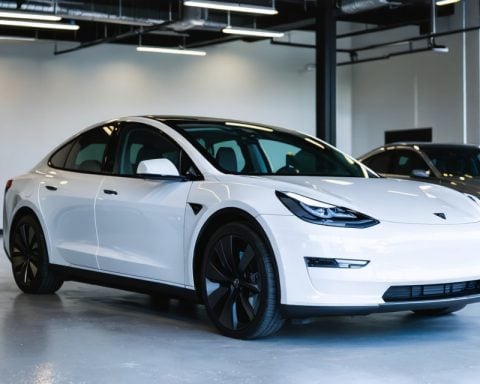- Electric vehicle (EV) batteries demonstrate remarkable durability, maintaining over 90% health past 120,000 kilometers.
- Testing by Pickles on over 250 used EVs reveals batteries performing well beyond expectations, even in vehicles older than four years.
- Highlighted brands include Hyundai, BYD, and Tesla, with Hyundai leading at 99.31% battery health.
- Findings dispel myths about rapid battery degradation and instill confidence in the used EV market.
- Durable batteries support innovations like bidirectional charging, potentially transforming cars into energy sources.
- With nearly 10% of new cars in Australia being electric, robust batteries are pivotal to the country’s sustainable future.
Beneath the sleek exteriors of electric vehicles (EVs) lies a powerful secret: those batteries are proving to be remarkably robust. Recent Australian research unveils a story of endurance, showing how even seasoned EVs with over 120,000 kilometers on the odometer maintain over 90% of their original battery health. This revelation flips the script for skeptics worried about battery degradation.
As automotive auction house Pickles tests a fleet of more than 250 used EVs, they reveal that batteries are outlasting expectations, maintaining a solid performance well into their mileage life. Those older than four years still clutch over 93% of their starting capacity, a testament to the advanced engineering behind modern EVs.
Across different brands, the findings shine. Hyundai takes the crown, with an impressive 99.31% battery health across an average of nearly 30,000 kilometers. Newcomer BYD and stalwart Tesla follow closely, all defying earlier assumptions about rapid battery decline. This presents a newfound confidence not only in the used EV market but also suggests a broader reliability across price points and origins.
The implications ripple through Australia’s energy landscape. As the country gears up for a greener future, EV batteries’ durability bolsters plans for bidirectional charging—using parked cars to feed energy back into the grid. Such innovations hint at a transformation where cars do more than drive; they power the nation.
In an era where nearly one in ten new cars sold in Australia is electric, these sturdy batteries aren’t just surviving—they’re heralding an electric revolution. They promise a future where sustainable travel isn’t just a dream but a reality embedding itself into the fabric of Australian roads.
Unlocking the True Potential of Electric Vehicles: How Durable Batteries Are Changing the Landscape
How-To Steps & Life Hacks: Maximizing EV Battery Health
To ensure your electric vehicle (EV) battery remains robust and efficient over time, consider these practical tips:
1. Maintain Optimal Charge Levels:
– Avoid regularly depleting the battery to 0% or charging it to 100%. Instead, keep charge levels between 20% and 80% for daily use.
2. Climate Control:
– Extremes in temperature can degrade battery health. Park in shaded areas during hot weather and garage your car in cold conditions when possible.
3. Mindful Driving Habits:
– Adopting smooth acceleration and braking habits can extend battery life by reducing stress.
4. Regular Software Updates:
– Keep your EV software updated for optimized battery management, as manufacturers often release updates to improve performance.
Real-World Use Cases: Electric Vehicles as Energy Reserves
The exploration of bidirectional charging—where EVs can both charge from and supply power back to the grid—has significant implications:
– Home Energy Storage: EVs can serve as backup power sources for homes during outages.
– Grid Stability: By discharging excess power during peak periods, EVs can help stabilize the energy grid.
Market Forecasts & Industry Trends
The EV market is experiencing rapid growth, with Bloomberg New Energy Finance predicting that EVs will make up 58% of global passenger vehicle sales by 2040. Battery longevity is a key driver in enhancing consumer confidence and expanding market share.
Reviews & Comparisons: Leading EV Brands
– Hyundai: Tops charts with an impressive average battery health of 99.31%. Known for reliability and efficiency.
– Tesla: Offers cutting-edge technology and extensive range, maintaining robust performance over time.
– BYD: Emerging as a strong contender with competitive pricing and sustainable energy solutions.
Controversies & Limitations
Despite the positive trends, challenges include:
– Charging Infrastructure: Expansion of charging networks is pivotal.
– High Initial Costs: Although battery prices are decreasing, upfront costs remain a barrier for some consumers.
Features, Specs & Pricing
EVs vary broadly in features and pricing:
– Tesla Model 3: Known for its range of up to 568 km, priced from $39,990.
– Hyundai Kona Electric: Offers a range of 484 km, starting at $37,390. Compact with strong performance metrics.
– BYD Atto 3: Provides a 420 km range, with pricing starting at $38,990, appealing to budget-conscious buyers.
Security & Sustainability
EVs offer substantial sustainability benefits:
– Reduced Emissions: Significant decrease in greenhouse gases over the vehicle’s lifetime compared to internal combustion engines.
– Recycling Initiatives: Advances are being made in recycling EV batteries to recover precious metals.
Insights & Predictions: The Green Future of Transportation
The combination of robust battery health and technological advancements hint at a future where EVs dominate the automobile industry. Continued improvements in battery tech promise further reductions in cost and enhancements in range and efficiency.
Tutorials & Compatibility
Integrating your EV into home energy systems can enhance sustainability. Tutorials on setting up bidirectional chargers can empower households to efficiently utilize energy resources.
Pros & Cons Overview
Pros:
– Low maintenance costs.
– Environmentally friendly.
– Quiet operation.
Cons:
– Limited charging infrastructure.
– Longer recharging times compared to refueling gas vehicles.
Actionable Recommendations
– For potential buyers: Consider total cost of ownership, including tax incentives and savings on fuel and maintenance when evaluating an EV purchase.
– For current EV owners: Focus on regular maintenance and software updates to ensure longevity and performance.
For those seeking more information and updates on electric vehicles and sustainability, visit Bloomberg for industry insights and trends.
With technology now supporting a robust EV ecosystem, embracing this sustainable mode of transportation is not just viable but increasingly practical. Implement these tips today to maximize your EV experience and contribute to a greener tomorrow.













